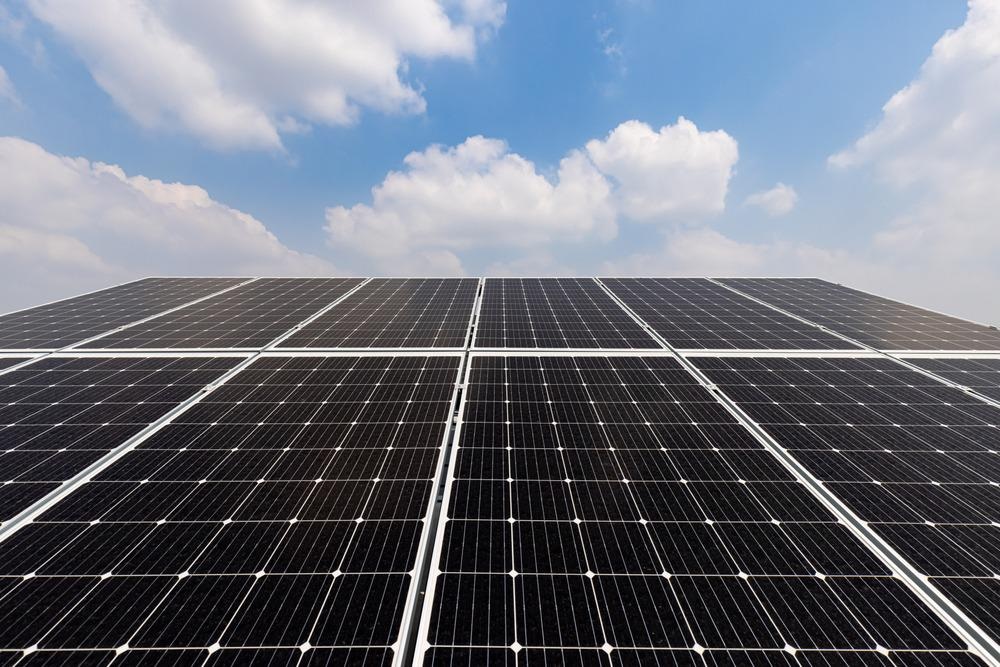In a recent study published in the journal Dyes and Pigments, researchers from the Republic of Korea developed a novel fluorine-based transparent and colorless ultraviolet (UV) light-harvesting dye for photovoltaic solar cells that can be fitted on to window glasses of urban buildings to meet the increasing energy demand for next decade.

Study: UV-harvesting dyes featuring a fluorene donor for visibly transparent and colorless dye-sensitized solar cells. Image Credit: Zentinel/Shutterstock.com
These UV-selective and transparent solar cells demonstrated a power conversion efficiency of 6.17%-8.13% under UV irradiation of 365 nm wavelength and 0.91%-2.70% under white light conditions. Additionally, it has a visible light transmittance of 60.73%-58.22%, which shows that it is suitable for urban visual comforting without absorbing too much visible light and selectively absorbing more UV and near-infrared (NIR) lights for higher energy conversion.
Transparent Dye-Sensitized Solar Cells
The window-fitted transparent dye-sensitized solar cells (DSSC) are an effective solution for selective absorption of solar irradiation of a particular range of wavelengths owing to the less occupation of land area, adequate visual comfort, and the ease of modification of their elemental compositions. Currently, DSSC use metal-free organic dyes, inorganic ruthenium (Ru)-based dyes, perovskite-based sensitizers, quantum-dot sensitizers, and natural dyes sensitizers.
Especially, the metal-free organic dyes or so-called donor-π bridge-acceptor (D-π-A) sensitizers have garnered more attention since the last decade and become a promising alternative to Ru-based dyes owing to their very high molar extinction coefficients, free form expensive and toxic Ru metal, easily tunable absorption energies, ease of synthesis, low cost, high stability under elevated temperature, and prolonged luminescence.
They consist of three parts viz. donors, linkers, and acceptors. Under the irradiation of a specific wavelength, the electron-rich donor moieties give their electrons to the acceptors through π-bond-conjugated linker bridges.
About the Study
In this study, researchers synthesized three fluorene donor-based D-π-A UV-sensitizing dye with different π-bridges made up of benzene, thiophene, and furan denoted as (E)-3-(4-(9H-fluoren-2-yl) phenyl)-2-cyanoacrylic acid (FPCN), (E)-3-(5-(9H-fluoren-2-yl) thiophen-2-yl)-2-cyanoacrylic acid (FTCN), and (E)-3-(5-(9H-fluoren-2-yl) furan-2-yl)-2-cyanoacrylic acid (FFCN), respectively, for window-fitted PV solar cell.
Transparent fluorine (F)-doped tin oxide (SnO2) (FTO) glass substrates of 2.2 mm thickness and 8 Ω/mm2 were cleaned and pre-treated with O2 plasma for 10 min and diluted TiCl4 solution for 30 min at 75 ℃. After that, TiO2 paste was screen printed on the FTO glass substrate followed by sintering at 300 ℃ for 30 min.
More from AZoM: Producing Polymers from Waste Sulfur
This TiO2 layer acted as the anode of the PV cell (i.e., photoanodes). Subsequently, the photoanodes were dipped in a separate solution of dimethylformamide (DMF) containing 0.7 mM of FPCN, FTCN, and FFCN dyes. A platinum (Pt)-based electrocatalyst was spin-coated and thermally reduced on the FTO substrate using a solution of chloroplatinic acid (H2PtCl6) and 2-propanol. The Pt layer acted as the cathode of the PV cell.
Observations
In all three D-π-A dyes, planar fluorene acted as the donor that enhanced the UV light-harvesting capacity in the short wavelength range, whereas the 2-cyanoacrylic acid acted as the acceptor. All donor molecules exhibited identical frontier molecular orbitals (FMOs) spatial distributions.
The valence electrons were at the highest occupied molecular orbital (HOMO) state and spread from the donor molecule to the π-bridge; meanwhile, the excited electrons were localized at the lowest unoccupied molecular orbital (LUMO) state along the π-bridge from the donor molecule towards the acceptor molecule (cyanoacrylic acid). Hence, a continuous charge transfer occurred from the electron donor molecule to the electron acceptor molecule under UV light.
The absorption band were 315-400 nm for UV light and 400-420 nm for violet light spectra. The strongest absorption peak was associated with HOMO to LUMO intramolecular charge transfer (ICT). The molar extinction coefficients of FFCN, FTCN, and FPCN dyes in EtOH were 31,000, 32,400, and 36,200 M−1.cm−1, respectively, and the corresponding bandgaps were 2.79, 2.79, and 3.14 eV, respectively.
Furthermore, all three dyes exhibited a lower HOMO state than the redox potential of -4.80 eV, indicating high electron gain from the electrolyte and complete regeneration ability. Similarly, they exhibited a higher LUMO state than the conduction band of the TiO2 layer, i.e., -4.00 eV, indicating that all three dyes spontaneously and efficiently transferred exciting electrons into the TiO2 layer.
Conclusions
In summary, the researchers synthesized metal-free organic so-called D-π-A UV-sensitizing transparent dye containing solar cells that can be fitted onto window glass, which can selectively harvest energy from UV light in a wavelength range of 315-420 nm without affecting the transmission of visible light.
The lower HUMO state than redox potential and higher LUMO state than the conduction band of the TiO2 layer indicated high regeneration ability efficient electron transfer efficiencies, respectively. Additionally, a high power conversion efficiency of 6.17%-8.13% for UV and high visible light transmittance of 60.73%-58.22% make it a promising dye for window-based solar cells.
Disclaimer: The views expressed here are those of the author expressed in their private capacity and do not necessarily represent the views of AZoM.com Limited T/A AZoNetwork the owner and operator of this website. This disclaimer forms part of the Terms and conditions of use of this website.
Source:
Marsya, M., Hayati, D., Han, S., Long, D., Choi, K., Hong, J., UV-harvesting dyes featuring a fluorene donor for visibly transparent and colorless dye-sensitized solar cells, Dyes and Pigments, 2022, 110131, ISSN 0143-7208, https://www.sciencedirect.com/science/article/pii/S0143720822000535